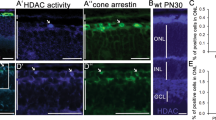Abstract
Cone photoreceptor loss is the main cause of color blindness and loss of visual acuity in patients suffering from inherited cone dystrophies. Despite the crucial role of cones in everyday life, knowledge on mechanisms of cone cell death and the identification of potential targets for the preservation or delay of cone loss are scarce. Recent findings have shown that excessive histone deacetylase (HDAC) activity is associated with both primary rod and primary cone degeneration. Importantly, pharmacological inhibition of HDAC activity in vivo at the onset of cone degeneration offers a prolonged protection of cones in a mouse model of inherited cone degeneration (cpfl1). In this study, we evaluated the potential of trichostatin A (TSA), a pan-HDAC inhibitor, to prevent cone cell death at a later stage of degeneration in the cpfl1 model. We demonstrate that a single intravitreal TSA injection protected the cpfl1 cones even when administered after the onset of degeneration. In addition, the TSA treatment significantly improved aberrant cone nucleokinesis present in the cpfl1 retina. These results highlight the feasibility of targeted cone neuroprotection in vivo even at later disease stages of inherited cone dystrophies.
Access this chapter
Tax calculation will be finalised at checkout
Purchases are for personal use only
Similar content being viewed by others
References
Arango-Gonzalez B, Trifunovic D, Sahaboglu A et al (2014) Identification of a common non-apoptotic cell death mechanism in hereditary retinal degeneration. PLoS One 9:e112142
Chang B, Hawes NL, Hurd RE et al (2002) Retinal degeneration mutants in the mouse. Vis Res 42:517–525
Jacobson SG, Cideciyan AV, Roman AJ et al (2015) Improvement and decline in vision with gene therapy in childhood blindness. N Engl J Med 372:1920–1926
Jakovcevski M, Akbarian S (2012) Epigenetic mechanisms in neurological disease. Nat Med 18:1194–1204
Kaplan H, Chiang C, Cheng J et al (2010) Vitreous volume of the mouse measured by quantitative high-resolution MRI. Invest Ophthalmol Vis Sci 51:4414
Koch S, Tsang S (2018) Success of gene therapy in late-stage treatment. Adv Exp Med Biol 1074:101–107
Mitamura Y, Mitamura-Aizawa S, Nagasawa T et al (2012) Diagnostic imaging in patients with retinitis pigmentosa. J Med Investig 59:1–11
Pow D, Sullivan R (2007) Nuclear kinesis, neurite sprouting and abnormal axonal projections of cone photoreceptors in the aged and AMD-afflicted human retina. Exp Eye Res 84:850–857
Simunovic M, Moore A (1998) The cone dystrophies. Eye 12:553–565
Trifunovic D, Dengler K, Michalakis S et al (2010) cGMP-dependent cone photoreceptor degeneration in the cpfl1 mouse retina. J Comp Neurol 518:3604–3617
Trifunovic D, Sahaboglu A, Kaur J et al (2012) Neuroprotective strategies for the treatment of inherited photoreceptor degeneration. Curr Mol Med 12:598–612
Trifunovic D, Arango-Gonzalez B, Comitato A et al (2016) HDAC inhibition in the cpfl1 mouse protects degenerating cone photoreceptors in vivo. Hum Mol Genet 25:4462–4472
Trifunovic D, Petridou E, Comitato A et al (2018) Primary rod and cone degeneration is prevented by HDAC inhibition. Adv Exp Med Biol 1074:367–373
Vighi E, Trifunovic D, Veiga-Crespo P et al (2018) Combination of cGMP analogue and drug delivery system provides functional protection in hereditary retinal degeneration. Proc Natl Acad Sci U S A 115:E2997–E3006
Write AF (2015) Long-term effects of retinal gene therapy in childhood blindness. N Engl J Med 372:1954–1955
Xu L, Kong L, Wang J, Ash JD (2018) Stimulation of AMPK prevents degeneration of photoreceptors and the retinal pigment epithelium. Proc Natl Acad Sci U S A 115:10475. pii: 201802724.
Acknowledgments
We thank N. Rieger for skillful technical assistance. This work was supported by the DFG TR-1238/4-1.
Author information
Authors and Affiliations
Corresponding author
Editor information
Editors and Affiliations
Rights and permissions
Copyright information
© 2019 Springer Nature Switzerland AG
About this paper
Cite this paper
Samardzija, M., Masarini, K., Ueffing, M., Trifunović, D. (2019). HDAC Inhibition Prevents Primary Cone Degeneration Even After the Onset of Degeneration. In: Bowes Rickman, C., Grimm, C., Anderson, R., Ash, J., LaVail, M., Hollyfield, J. (eds) Retinal Degenerative Diseases. Advances in Experimental Medicine and Biology, vol 1185. Springer, Cham. https://doi.org/10.1007/978-3-030-27378-1_63
Download citation
DOI: https://doi.org/10.1007/978-3-030-27378-1_63
Published:
Publisher Name: Springer, Cham
Print ISBN: 978-3-030-27377-4
Online ISBN: 978-3-030-27378-1
eBook Packages: Biomedical and Life SciencesBiomedical and Life Sciences (R0)




